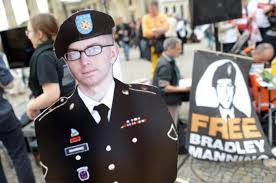Alex Constantine - August 15, 2014
By Katherine Hawkins
When the executive summary of the Senate Select Committee on Intelligence’s (SSCI) report on the CIA’s torture program is finally released, it is likely to discredit a story that defenders of “enhanced interrogation” have been telling for years. The narrative first appeared in the Office of Legal Counsel (OLC) memos that authorized the CIA program. President Bush repeated it in his September 2006 speech acknowledging the existence of CIA prisons, and in 2008 when he vetoed a bill outlawing waterboarding. Slightly different versions appear in Bush’s memoirs, and defenses of the CIA program by George Tenet, Michael Hayden, Michael Mukasey, Jose Rodriguez, John Yoo, Dick Cheney, and others.
The narrative goes something like this: torture is un-American, but the CIA program was not torture. Unlike the awful abuses depicted in the Abu Ghraib photographs, the CIA’s program was carefully overseen, conducted by experienced, trained professionals, and limited to the most dangerous terrorists in the world. Only thirty or so detainees were subjected to any form of “enhanced interrogation,” and only three were waterboarded. Interrogators inflicted only as much suffering on detainees as they determined was necessary to save American lives. Medical and mental health professionals carefully monitored interrogations to make sure that detainees would not suffer severe pain, and no detainee had shown any evidence of lasting harm. And it worked. The United States gained actionable intelligence, which we could not have acquired any other way. The CIA program saved hundreds of lives, if not thousands.
But carefully regulated, professionally conducted cruelty is an illusion, as Professor Darius Rejali warns in his exhaustive book on the subject, Torture and Democracy:
To think professionalism is a guard against causing excessive pain is an illusion. Instead, torture breaks down professionalism. Professionals become less disciplined, more brutal, and less skilled while their organizations become more fragmented and corrupt. (p. 454)
Rejali warns of three specific ways in which torture tends to spread, and corrupt the organizations that use it:
First, torturers go beyond the specified suspects to torture individuals not normally tortured. Second, torturers go beyond the approved techniques to a broader range of brutalities. Third, torturers break away from the bureaucratic oversight. (p. 530).
Both the leaked “findings” of the Senate report on CIA torture, and the publicly available evidence of the program’s history, suggest that this is exactly what happened during the CIA program. And while the CIA has closed its secret prisons and stopped using “enhanced interrogation”, the agency’s response to the Senate report demonstrates that its resistance to democratic oversight continues to this day.
Going Beyond the Approved Suspects and Approved Techniques
According to McClatchy, the findings of the Senate torture report include the following:
The CIA subjected detainees to interrogation techniques that had not been approved by the Department of Justice or had not been authorized by CIA Headquarters.
–
The CIA did not conduct a comprehensive or accurate accounting of the number of individuals it detained and held individuals who did not meet the legal standard for detention. The CIA’s claims about the number of detainees held and subjected to enhanced interrogation techniques were inaccurate.
–
The CIA’s use of enhanced interrogation techniques was brutal and far worse than the agency communicated to policymakers.
–
The conditions of confinement for CIA detainees were brutal and far worse than the agency communicated to policymakers.
The publicly available evidence on the CIA program supports these findings. The agency claimed that only approximately 30 high-level detainees were subjected to “enhanced interrogation.” But that estimate cannot be accurate unless it excludes CIA prisons in Afghanistan, where many more than thirty men were held under conditions that the detainees claim, and courts have repeatedly found, amounted to torture. One of them, Gul Rahman, died in CIA custody. Others, like German citizen Khaled el-Masri and AlgerianLaid Saidi, appear to be innocent of any involvement in terrorism.
The agency claimed that only three detainees were waterboarded—Abu Zubaydah, Abd al Rahim al Nashiri, and Khalid Sheikh Mohammed. But two other former detainees, Libyans Mohammed al-Shoroeiya and Khaled al-Sharif, gave Human Rights Watch “detailed and credible testimony” of being subjected to suffocation with water in CIA custody in Afghanistan.
The CIA said that its interrogations used only authorized “enhanced” techniques, always within careful limits. It reassured the Justice Department that doctors and mental health professionals carefully monitored each interrogation to ensure that detainees’ suffering never reached the point of torture. The agency claimed that none of the prisoners it waterboarded showed “any evidence of physical pain or suffering or mental harm…more than 25 months” later, and that no detainee deprived of sleep by being shackled naked to the ceiling “has suffered any harm or injury.”
Despite the pervasive censorship in place at Guantánamo, where the Executive Branch takes the position that detainees’ descriptions of their own torture are classified, there is evidence that every single one of those claims is false. Abd al Rahim al Nashiri was tortured not only with authorized techniques, but threatened with mock execution with a handgun and a power drill. He was also “sexually tortured” and suffered ongoing physical problems as a result, according to recent testimony from Dr. Sondra Crosby, who examined him at Guantánamo. Both Dr. Crosby and an independent military panel diagnosed Nashiri with post-traumatic stress disorder.
Abu Zubaydah allegedly suffers from chronic pain, frequent seizures, and memory loss as a result of his treatment in CIA custody. Khalid Sheikh Mohammed’s lawyer hassought permission to photograph scars on his clients’ wrists and ankles. Ramzi Bin al Shibh’s mental competence to stand trial has been called into question. Ali Abdul Aziz Ali, better known as Ammar al-Baluchi, allegedly suffered traumatic brain injury in CIA custody. Baluchi’s lawyers are not permitted to publicly allege what caused his symptoms, but the Washington Post has reported that “CIA interrogators forcibly kept his head under the water while he struggled to breathe and beat him repeatedly, hitting him with a truncheon-like object and smashing his head against a wall” at a secret prison in Afghanistan.
In Iraq, the Geneva Conventions applied, and the CIA was not supposed to detain prisoners at all. It nevertheless repeatedly questioned unregistered “ghost prisoners” in military custody—including at Abu Ghraib. The corpse that appears in multiple Abu Ghraib photographs is that of a CIA ghost detainee, Manadel al-Jamadi, who died after agency operative Mark Swanner instructed military police to shackle him with his hands behind his back to a window frame.
Avoidance of Oversight During the Program
A number of the SSCI report’s purported findings concern CIA deception and obstruction of oversight under the Bush administration:
Numerous internal critiques and objections concerning the CIA’s management and use of the Detention and Interrogation were ignored.
–
The CIA impeded oversight by the CIA’s Office of Inspector General.
–
The CIA repeatedly provided inaccurate information to the Department of Justice, impeding a proper legal analysis of the CIA’s Detention and Interrogation Program.
–
The CIA inaccurately characterized the effectiveness of enhanced interrogation techniques to justify their use.
–
The CIA impeded effective White House oversight and decision-making.
–
The CIA has actively avoided or impeded Congressional oversight of the program.
–
The CIA manipulated the media by coordinating the release of classified information, which inaccurately portrayed the effectiveness of the agency’s enhanced interrogation techniques.
Again, there is already a great deal of evidence to support most of these findings. The Department of Justice’s authorization for the torture program, particularly in its later years, relied very heavily on CIA claims that “the intelligence acquired from these interrogations has been a key reason why al-Qa’ida has failed to launch a spectacular attack in the West since 11 September 2001” (p.29). The Constitution Project’s bipartisan, independent Task Force on Detainee Treatment (for which I served as the investigator) examined several of these claims in detail, and found them to be false or dubious.
The CIA did not brief the full House and Senate intelligence committees about its treatment of prisoners until September 2006, only days before President Bush publicly acknowledged the black site program. A few members of Congress were briefed earlier, but these briefings occurred under extremely restrictive circumstances (p. 41). Senators and Representatives could not take notes, or discuss the briefings with staff or other members of Congress. Stephen Preston, the former CIA General Counsel, has acknowledged that the Congressional briefings that did occur “included inaccurate information related to aspects of the program of express interest to Members.”
The CIA destroyed evidence of torture. The best-known instance of this is Jose Rodriguez’sdestruction of videotapes of “enhanced interrogation” sessions, but there were other examples as well. For example, the CIA “lost” the sandbag that covered Manadel al-Jamadi’s head at the time of his death. According to government documents, CIA officers gave investigators from the Office of the Inspector General (OIG) an explanation for the hood’s disappearance that was uncorroborated and “not believable.”
These conclusions, and a series of other OIG reports critical of the interrogation program, led to some changes to the program. But they also led the CIA to investigate its own Inspector General’s office in 2007. Then-CIA director Michael Hayden ordered the review in response to complaints that OIG was investigating the detainee program with “a prosecutorial mentality” that was harming morale.
Continued Avoidance of Oversight, and Attacks on Overseers
When he took office, President Barack Obama ended the CIA torture program over the agency’s objections (though troubling questions remain about the CIA’s role in torture by Afghanistan’s National Directorate of Security and other foreign proxies). Obama ordered declassification of OLC memos that described, in graphic detail, the “enhanced interrogation techniques” that the CIA had been authorized to use. Despite Obama’s preference for “looking forward,” and a commitment that he would not prosecute CIA officers who had relied on OLC advice that their actions were lawful, Attorney General Eric Holder ordered a limited investigation into cases where CIA officers went beyond the abuses that OLC authorized.
But since 2009, the Obama administration has increasingly deferred to the CIA on how to deal with the legacy of the agency’s experiment with torture.
The Department of Justice has closed all of its criminal investigations without any charges. As is customary, it provided no explanation for why it declined prosecution. Every civil suit by former CIA detainees has been dismissed. The Executive Branch successfully opposed Freedom of Information Act requests for information about the program, on grounds that they would require disclosure of “sources and methods”. These included not only the CIA cables describing what the agency did to prisoners, but eleven Office of Inspector General reports into the program that remain classified in their entirety—including the OIG inquiry into Manadel al-Jamadi’s death. The CIA explained in court declarations that the declassified OLC memos only described its “enhanced” techniques “in the abstract” (p. 6). The details of any individual’s treatment in CIA custody were still top secret.
At Guantánamo, the Obama administration continued the Bush administration’s policy of censoring former CIA prisoners’ descriptions of their own torture—even as the CIA’s prepublication review board approved several memoirs making detailed claims about the same detainees’ interrogations. The administration has also resisted providing evidence of high value detainees’ torture to their military commissions defense lawyers, although the lawyers hold top secret clearances, and this evidence will be essential to their argument against a death sentence.
There is little evidence of CIA officers having faced administrative penalties for involvement in torture. The Associated Press reported in 2011 that several officers involved in Khaled El-Masri’s kidnapping and Gul Rahman’s homicide have been promoted. TheNew York Times recently reported that this April, the head of the CIA’s counterterrorism center told John Brennan that 200 people involved in the detainee program still worked for him, and they wanted to know how Brennan was going to defend them from the Senate’s torture report.
Brennan reportedly described the SSCI as a “prosecutor’s brief,” (p.132) and the CIAresponded in June 2013 with a brief for the defense. When Senators noticed the contradictions between the agency’s official response and an earlier internal CIA review—commonly known as the “Panetta Review”—that acknowledged the programs’ flaws, they began to ask some awkward questions about the discrepancies. In response, as described by Senator Dianne Feinstein on the Senate floor in March,
The CIA did not ask the committee or its staff if the committee had access to the Internal Review, or how we obtained it. Instead, the CIA just went and searched the committee’s computers… the CIA’s unauthorized search of the committee computers was followed by an allegation—which we have now seen repeated anonymously in the press—that the committee staff had somehow obtained the document through unauthorized or criminal means, perhaps to include hacking into the CIA’s computer network.
Feinstein went on to describe how the CIA’s then-Acting General Counsel, Robert Eatinger, made a criminal referral of Senate staffers to the Department of Justice. Feinstein said that Senate report mentioned Eatinger “by name more than 1,600 times,” and described how he and other CIA officers “provided inaccurate information to the Department of Justice about the program.” She denounced the CIA’s search as unlawful, and the criminal referral as an attempt at intimidation. (The Department of Justice has since announced that it would not launch criminal investigations into either Senate staffers or CIA officials for searching Senate files.)
Brennan said that Feinstein’s allegations were “beyond the scope of reason,” and the CIA’s actions were lawful and appropriate. But after the CIA OIG completed its report into the incident, he abruptly changed his mind, and apologized. According to a public summary of the OIG report, CIA employees: (1) improperly accessed Senate staffers’ computer files; (2) searched and read Senate staffers’ emails; (3) provided “inaccurate information” to the Acting General Counsel, leading him to file a criminal referral against Senate staffers that was “not supported”; and (4) “demonstrated a lack of candor” in interviews with OIG.
Soon after, the White House returned a declassified version of the executive summary of the SSCI report with redactions that Feinstein said “eliminate or obscure key facts that support the report’s findings and conclusions.” The report’s release has been indefinitely postponed while the White House and Senate negotiate over the redactions.
On August 12, in response to these developments, twenty public interest organizations sent a letter to President Obama asking him to take three concrete steps:
- Replace John Brennan as CIA Director;
- Declassify the CIA Inspector General’s report on the CIA’s searches of Senate computers;
- Remove the excessive redactions of the Executive Summary of the Senate torture report, and declassify the full report.
We expect that the first of these requests will receive the most attention. But the other two are every bit as important. The problem did not begin with John Brennan, nor will it end with him, even if he resigns or is fired. The problem is that no bureaucracy can be trusted with the power to disappear people, torture them, and then disappear the evidence of these abuses.
FILED UNDER: Executive & Military, Guest Post
ABOUT THE AUTHOR
Katherine Hawkins (@krhawkins5) is the National Security Fellow at OpenTheGovernment.org. She previously served as the investigator for the Constitution Project's Task Force on Detainee Treatment.







